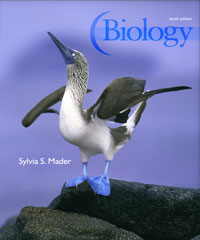Biology (Mader), 10th EditionChapter 3:
The Chemistry of Organic MoleculesLearning OutcomesAfter studying this chapter, you should be able to accomplish the following outcomes. Organic Molecules- List the features of carbon that result in the diversity of organic molecules.
- Tell how macromolecules are assembled and disassembled.
Carbohydrates- Name the most common 5 and 6-carbon sugars and give a function for each.
- Compare the structures of starch, glycogen, and cellulose and give a function for each
Lipids
- Compare the structures of fats, phospholipids, and steroids.
- State the primary function of fats and oils in cells.
- Compare the functions of phospholipids and steroids in cells.
- Describe the structure and function of waxes.
Proteins
- State six functions of proteins in cells.
- Tell how amino acids are the same and how they can be different from one another.
- List and discuss four levels of a protein's structure, and tell how protein folding diseases relate to structure.
Nucleic Acids
- Compare the structure and function of DNA and RNA in cells.
- Relate the structure of ATP to its function in cells.
 | 




